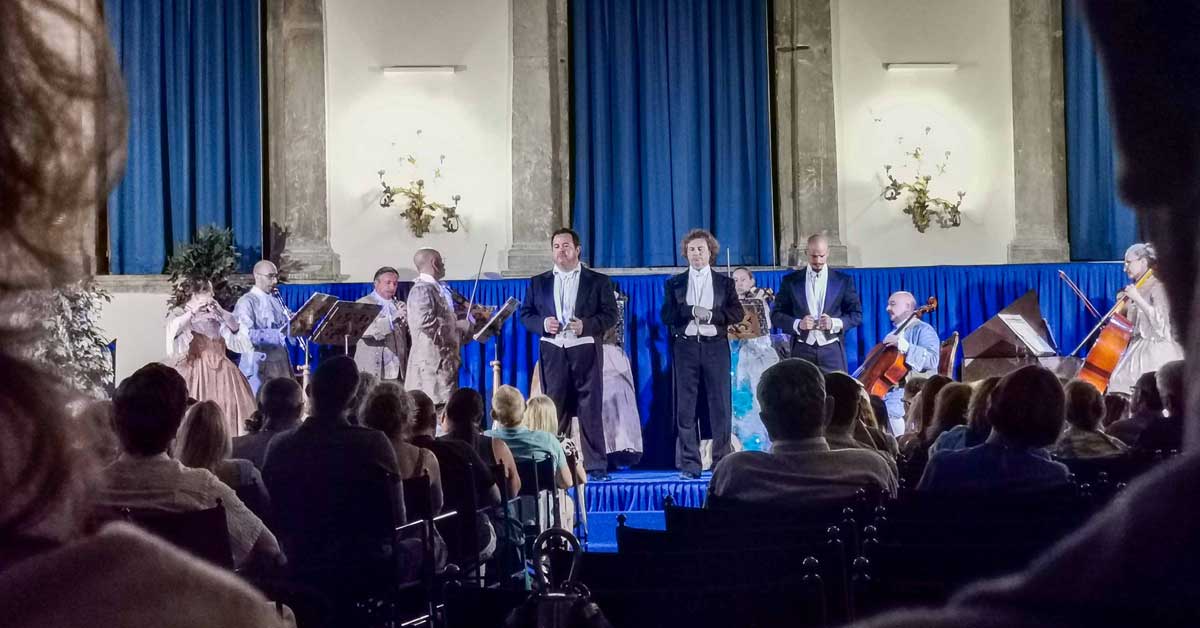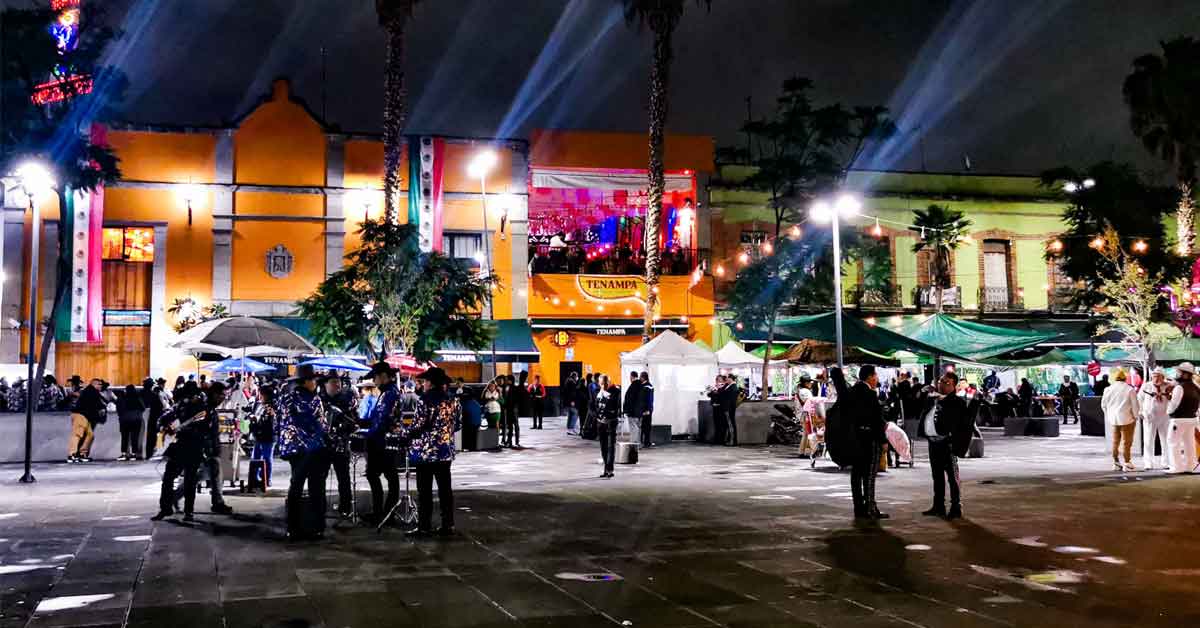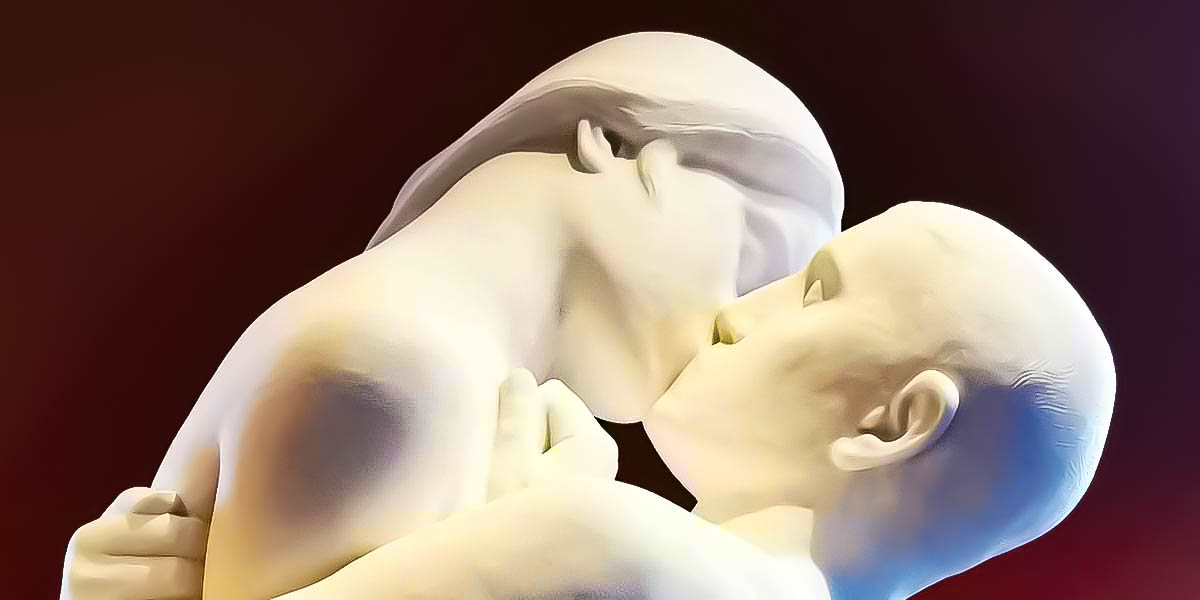A Day at the Capitol, Washington D.C.: Things to Know Before You Go – Tours, Tickets & Must-See
Wondering it it’s possible to visit the U.S. Capitol, how much time you need to spend inside and if it’s worth it? Below, all tips needed to plan your day at the Capitol.
The U.S. Capitol is one of the most impressive and significant architectural wonders in the whole world. Serving as the seat of the United States Congress, for both Senate and the House of Representatives, it’s where laws are made and history is written.. LIVE! Plus, beyond its political role, the Capitol doubles as an extraordinary museum of American art and history, a monument to the nation’s founders.
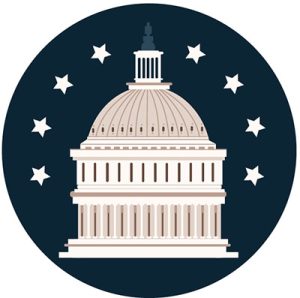
When the Capitol was built, the city had only 13.000 citizens, out of which 3.000 were involved in its construction. And they were planning to make it tall enough to host the Statue of Liberty.
Simply put, the Capitol is the symbol of American Democracy.
The building is located at the eastern end of the National Mall area, nearby many other free-to-visit museums in Washington D.C.
I went there in mid-October, around lunch time, got tickets by luck, and without even making a reservation. And spent about one day visiting both the Capitol, and Library of Congress.
Disclosure: This article contains affiliate links. If you make a purchase after clicking one of these links, I earn a small commission from that website at no extra cost to you. Learn more: Disclosure policy.
 Planning Your Visit
Planning Your Visit
Visiting the Capitol does require a bit of planning ahead. After all, it’s one of the most iconic buildings in the whole world. Its Visitors’ Center welcomes between 3,000 and just over 10,000 people each day, depending on the season. If you add up, almost 3 million per year. And that’s quite a lot of people!
Many are curious to witness democracy in action, the spirited debates and legislative proceedings in the House and Senate chambers. But beyond the political, the Capitol’s Visitor Center provides interactive exhibits, guided tours, and various educational programs on American history, art and architecture.
- ⏰ Open for tours: Monday – Saturday, from 8:30 a.m. – 4:30 p.m.
- 📌 Entrance: underground East Front Plaza, between Constitution & Independence Avenues, Location;
- 🎟️ Admission fee: visiting is free of charge, but you need a ticket to get in line.
- 🎟️ Best paid tour: Small-Group Guided Tour inside US Capitol & Library of Congress
How to Get There
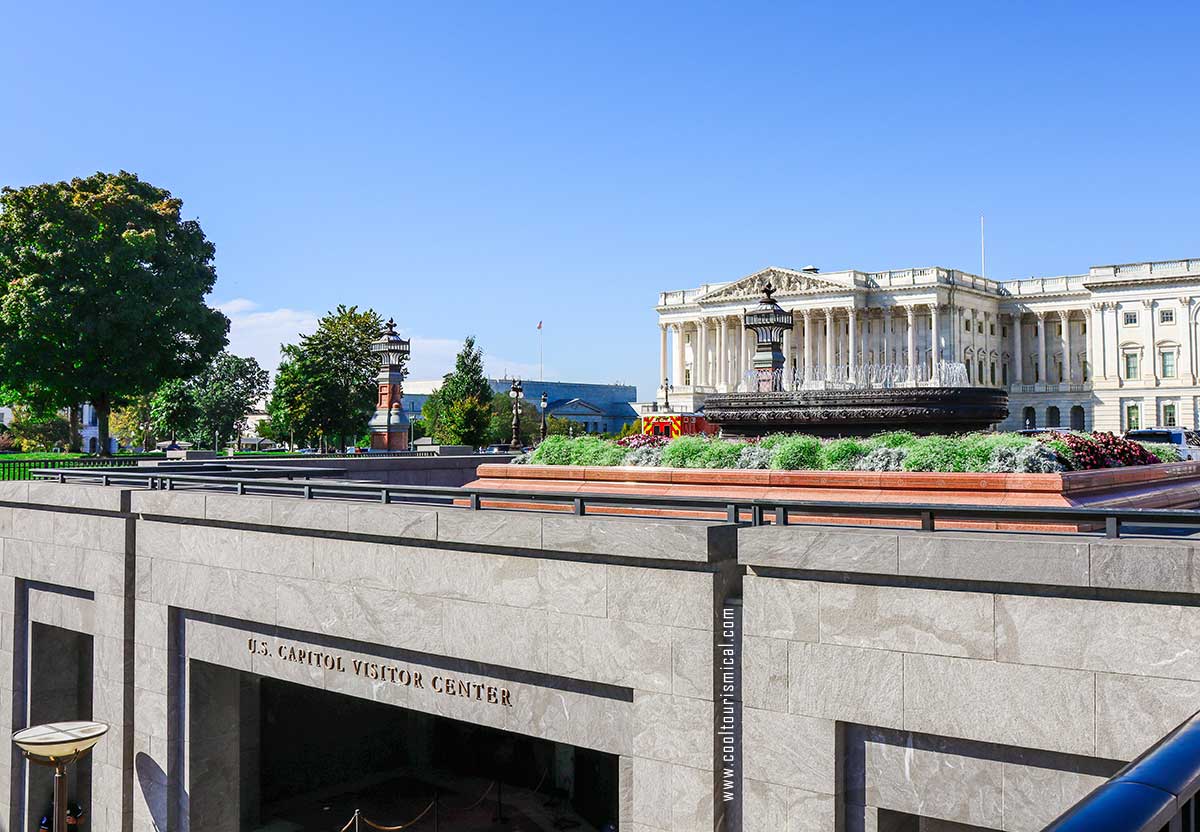
U.S. Capitol Visitor Center Access View, Copyright © Cooltourismical.com
The best way to get to the Capitol Hill in Washington D.C. is by Metro.
The closest Metro station is Capitol South, on the Blue, Orange, and Silver Lines, just a short walk from the Capitol. At Capitol South station, once you get to the top of the escalator, you will find yourself in front of the Republican National Committee building. Take left and reach independence Avenue. Take again left there you are, on the Capitol Hill.
In case you decide to come by car, the Capitol Hill is a secure area and parking is restricted. Many people complain about missing their tours for not finding a parking spot! The nearest public parking is at Union station, half a mile distance (approx. 800 meters) and you’ll have to walk for a bit longer.
The main access to the US Capitol Visitor Center is underground of the East Front Plaza, between Constitution & Independence Avenues. Location.
U.S. Capitol Guided Tours
There are several options available for exploring the magnificent Capitol.
International visitors, for instance, can choose the general guided tour offered by the Capitol itself. To secure a spot, make a reservation online and visit the Visitor Center. It’s best to book at least a month in advance!
If you didn’t book and find yourself confused, as I was, you might find a limited number of same-day passes available at the first ticket counter, on the left, during the off-season (for me, it was mid-October).
However, I wouldn’t rely on this. In peak season, booking at least a month in advance is necessary.
Another option, besides the free tour, is a paid guided tour with a tour operator from outside the Capitol, which includes the Library of Congress as well. These tours are slower paced, with much smaller groups, and much more insights. You’ll find the differences in the comparative table below.
Lastly, there’s a third option, but not for everyone. If you’re an American, you’re in luck! You can bypass the crowds by arranging a free private tour directly through your Congressman. Consider doing this a few months before your visit.
Free Official Tours
- Tour duration: 45 minutes.
- Group size: 30-50 people.
- You will receive headphones and a US Capitol Tour Guide.
- Includes: The Crypt, The Rotunda, National Statuary Hall.
- A bit rushed and strict.
- Does not include: Library of Congress, Capitol Hill, Supreme Court, Congress.
- Available for: nationals and foreigners.
- Booked at least one or two months in advance, online.
Paid Tours
- Tour duration: 3 hours.
- Group size: 15 people.
- You will receive headphones and a private tour guide.
- Includes: Free Official Tour areas, plus: Library of Congress, Capitol Hill, Supreme Court.
- More relaxed, entertaining and informative.
- Does not include: the Congress.
- Available for: nationals and foreigners.
- Available to book even with one or two days before your visit.
Congressman Tours
- Tour duration: 1-2 hours.
- Group size: 15 people group or less, or private, depending on the congressman.
- Includes: free tour of the US Capitol, sometimes also the Congress galleries.
- Does not include: Library of Congress, Capitol Hill.
- Available for: nationals only.
- Booked through the congressman, preferably a few months in advance.
📌 Good to know: Arrive about 20 minutes early to clear security and find your way through the building. Lines can be long during peak season. Backpacks and food are not permitted inside.
Tours Passing By the Capitol
If visiting the Capitol is on your Washington to-do list, but not high enough to dedicate one day for it, you can always choose to join some tours that include passing by the Capitol.
Best Time to Visit the U.S. Capitol
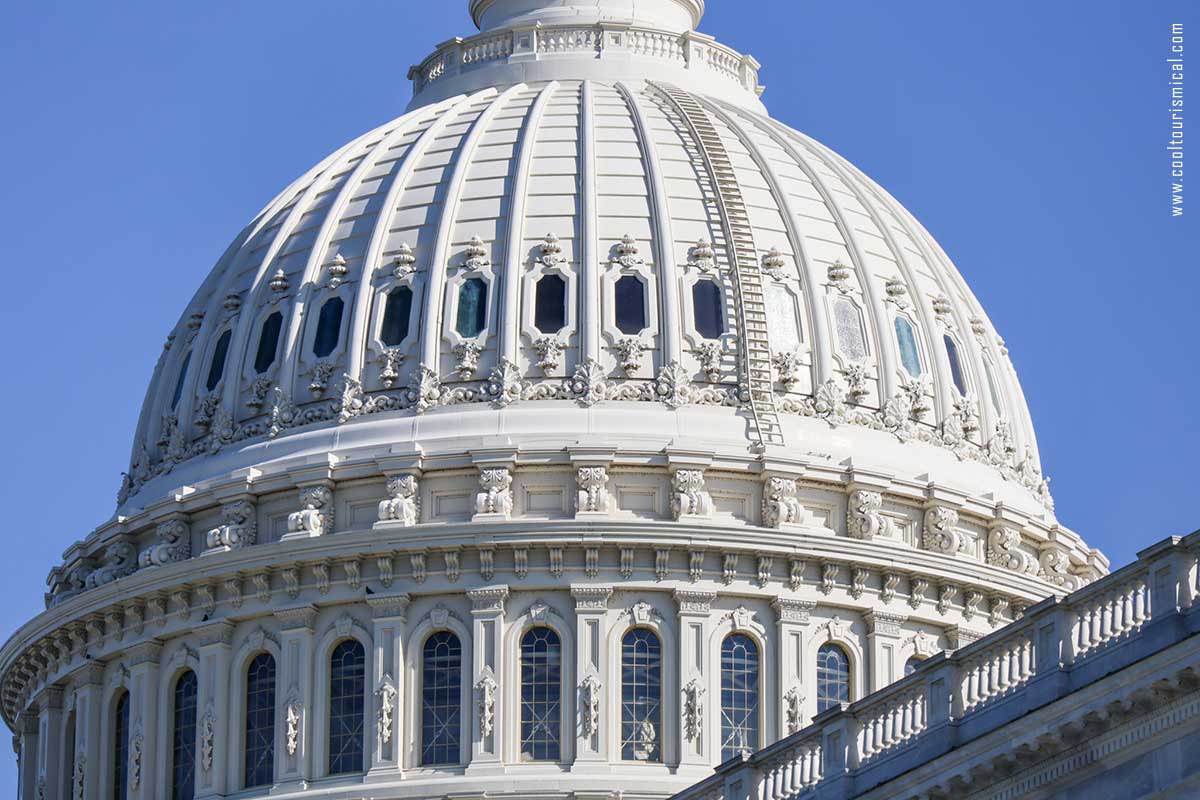
When to visit the Capitol depends on what you’re searching for. That could be pleasant weather in Washington D.C., fewer crowds inside the Capitol, or the chance to witness the government in action.
Spring (March to May) and fall (September to November) are widely regarded as the best times to visit Washington, D.C., including the Capitol. The weather is almost perfect for exploring the city on foot. Spring also brings added beauty as the cherry blossom season, building up this stunning backdrop, particularly around the National Mall.
Always book at least a month in advance. Never rely on the same-day passes that might or might not be available. When I checked on March 11th, the earliest available slot was April 9th.
Summer (June to August) tends to be peak tourist season, which means larger crowds and longer waits for tours of the Capitol.
If you don’t like crowds, holiday weeks, at any time of the year must also be avoided, because tourist numbers tend to surge again.
Mornings or afternoons are extremely popular times, but from around 11:30 a.m. to 03:00 p.m., it tends to be less crowded.
If you want to observe Congress in session, keep an eye on the congressional calendar. During my trip, I did visit the galleries of the Senate and The House of Representatives, but they were not in session. It was Thursday, from what I can remember, and the next session was on Monday. Note that during August, Congress is often in recess.
Getting Around The Capitol Building
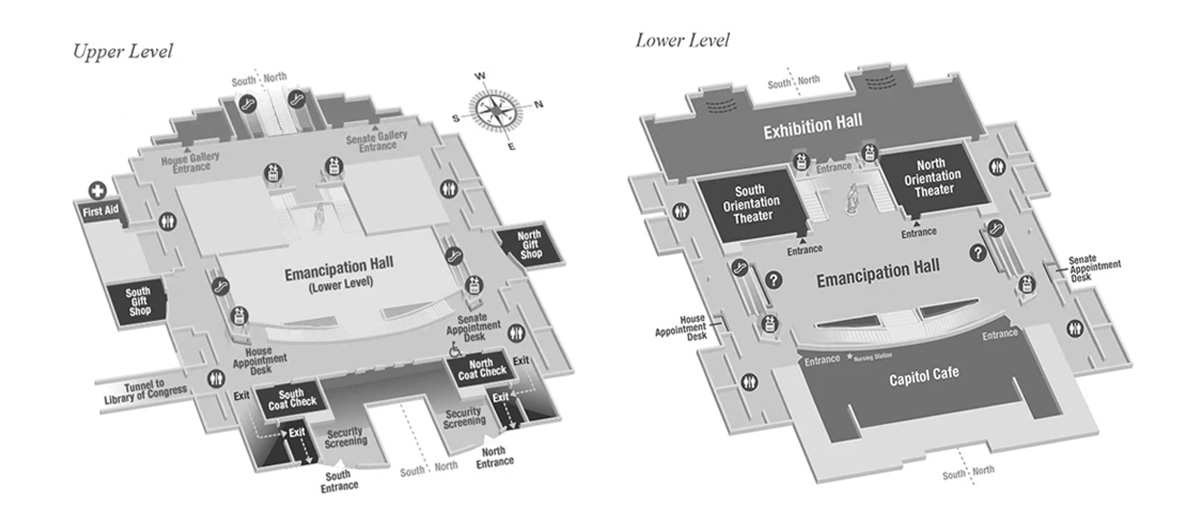
To get around easily, it’s important to know that the U.S. Capitol Visitor Center, located in the underground, has two levels, while the Capitol itself has five levels (with the basement and 4th floor not accessible to the public).
All floors of the U.S. Capitol are connected through a combination of stairs, elevators, and escalators, ensuring full accessibility for all visitors, including those with mobility problems. During the official tour that takes you to the Crypt, Rotunda and National Statuary Hall, you will primarily use staircases and escalators. I used elevators to access the Galleries level on my own.
US Capitol Visitor Center
- Upper Level serves as the main entrance, where visitors pass through Security Screening. Here, you’ll find appointment desks and entrances for international visitors to the House and Senate, as well as the tunnel leading to the Library of Congress. Other amenities: first aid stations, gift stores, coat checks, and restrooms.
- From the Upper Level, you descend to the Lower Level, into the Emancipation Hall. This is the central starting point for all tours, named in honor of the enslaved laborers who helped build the Capitol. In Emancipation Hall, there are the information and ticket desks, a café, and an exhibition hall offering a very nice introduction to the Capitol’s history and function. Plus, the Orientation Theaters, where official tours begin with a short film.
The Capitol Floors
- Basement/Terrace Level: Primarily used for offices, machinery, and workshops, this level supports the Capitol’s operations and is not open to the public.
- Ground Floor (First Floor): This floor houses committee rooms and congressional offices. Public areas include the Hall of Columns, Brumidi Corridors, the Old Supreme Court Chamber, and the Crypt, where historical exhibits are displayed.
- Second Floor: Home to the main chambers of the Senate and House, this floor also features key public spaces like the Rotunda, National Statuary Hall, and the Old Senate Chamber.
- Third Floor: Visitors can access galleries on this floor to observe House and Senate sessions. It also includes additional offices, committee rooms, and press galleries.
- Fourth Floor: Similar to the basement, this floor is dedicated to offices and support functions and is not accessible to the public.
The public elevators connect the following floors: Galeria, Rotunda, Crypt, Basement, UL – visitors’ center.
📌 Remember to grab a map of the Capitol and Visitor Center from the information desks to help navigate the space.
 Morning Time: Things to Do & See at the Capitol
Morning Time: Things to Do & See at the Capitol
The highlight of any visit to the U.S. Capitol in Washington, D.C., is undoubtedly the official guided tour. This complimentary tour, led by a knowledgeable Capitol representative, can be taken on its own (by booking a ticket well in advance with the Capitol directly) or as part of a more comprehensive, paid tour offered by external agencies.
Starting at the Visitor Center, the tour covers significant parts of the building, including the stunning Rotunda with its impressive fresco, “The Apotheosis of Washington”, the National Statuary Hall, filled with sculptures of prominent Americans and the Crypt, located below the Rotunda, the architectural and historical foundation of the Capitol.
Regardless of whether you choose a free or paid option, your experience will begin with the official guided tour.
If you’re an early riser, consider opting for a paid tour that begins with the official tour of the Capitol and continues to the Library of Congress and Capitol grounds. And you can leave for the afternoon things you can see on your own, such as the Congress Galleries. Your agency will be in charge of getting you in line.
Otherwise, if you prefer a later start and see everything at your own pace, you can take independently the official guided tour in the morning, visit the Congress Galleries, and save the Library of Congress and grounds for the afternoon. You will be responsible for booking your tickets well in advance or getting some day-passes at the information desk, on the spot, if available.
Tour Introduction (free & paid tour)
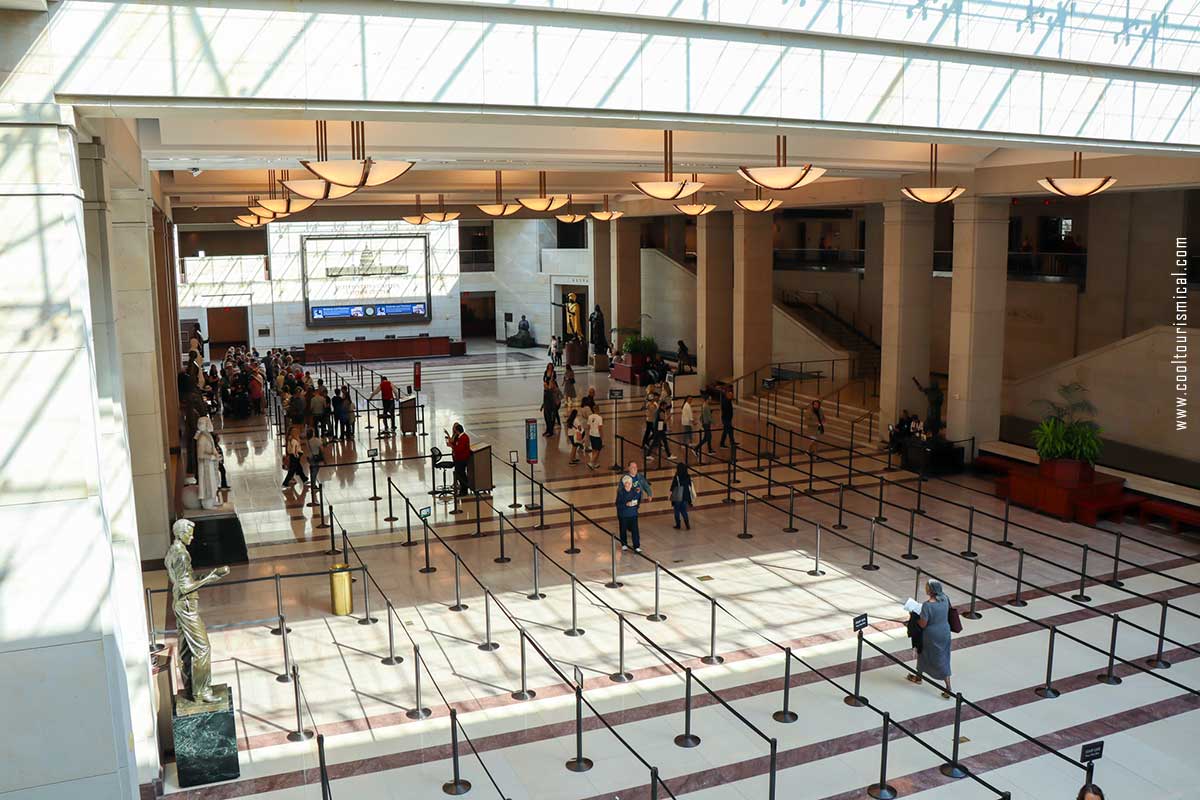
Information & Ticketing Desks in the Emancipation Hall, Copyright © Cooltourismical.com
One way or another, you have your tickets. Now what?
Regardless of your choice, the official classic tour inside the Capitol begins in a sea of people, where you are handed headphones and asigned an official guide, with a long wait to enter one of the two Orientation Theaters. The theaters show an introductory film, “Out of Many, One,” a historical overview of the Capitol and its role in the U.S. government.
From here, following your guide and moving between the different levels to access the spaces open to the public (the Crypt, Rotunda and National Statuary Hall) can be somewhat confusing, and it’s done via escalators, stairs, and elevators—apparently, an organized but crowded labyrinth. My advice is to stick with your group, or you might get lost.
The Crypt (free & paid tour)
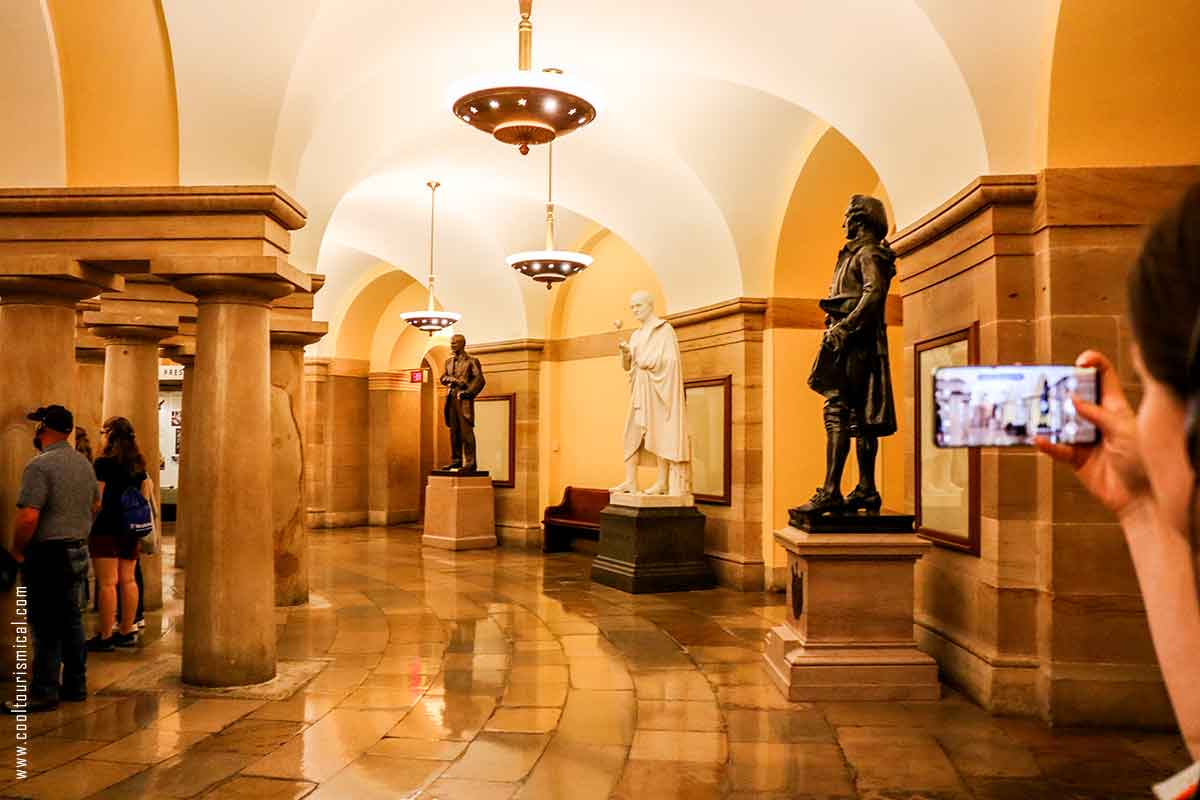
Inside Capitol’s Crypt, Copyright © Cooltourismical.com
The tour often passes first through the Crypt, a circular room located directly beneath the Rotunda, with the Rotunda meaning the interior space covered by the grand central dome of the Capitol building.
The Crypt houses 13 statues representing the original 13 colonies that declared their independence from Britain and formed the United States. There, you’ll also meet Napoleon who had bought Louisiana, an one-ear Lincoln statue, and a 20th-century magnificent clock.
The room is filled with Doric sandstone columns that support the dome, and has been long known as the crypt purely because of its architectural resemblance to underground chapels or tombs, usually found in churches.
The Crypt serves as the foundational layer of the Capitol, both literally and figuratively. The central white marble “compass stone” on its floor marks the heart of the Capitol and the reference point for dividing the city of Washington D.C. into its four quadrants.
The Rotunda (free & paid tour)
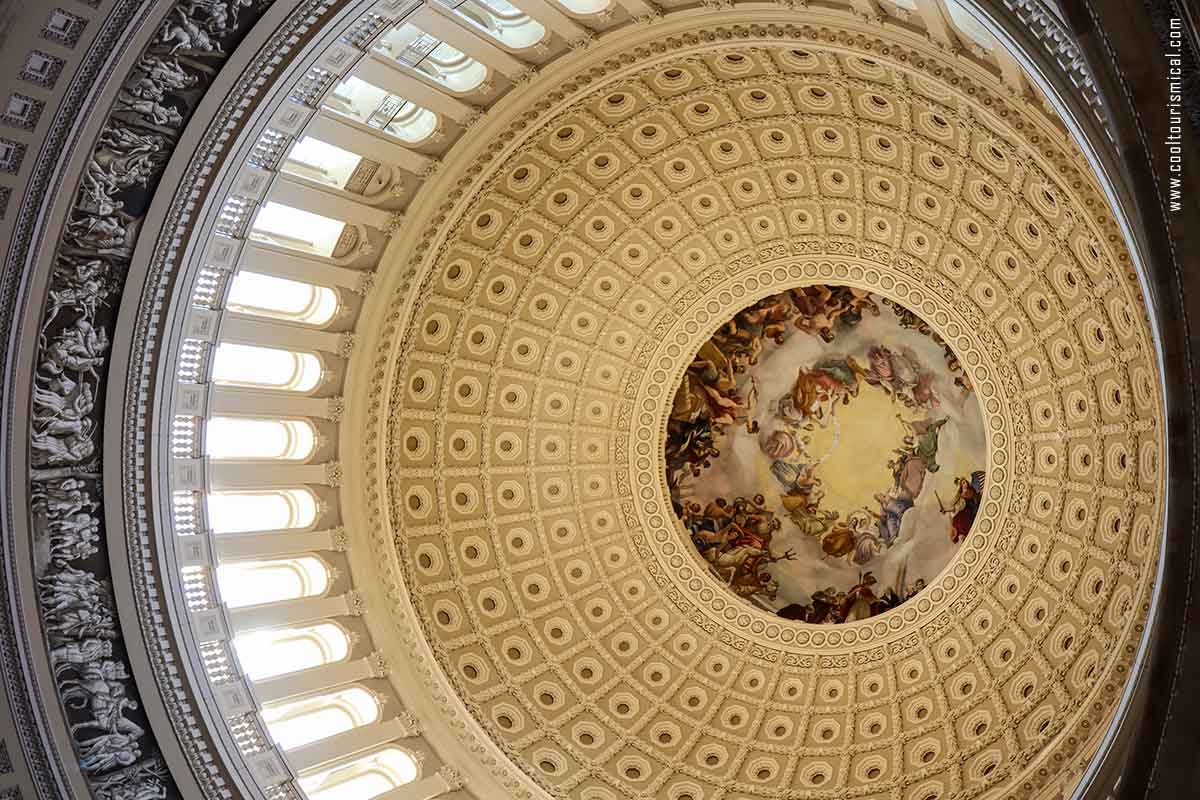
Capitol’s Rotunda Domed Ceiling, Copyright © Cooltourismical.com
Rising above the Crypt, the Rotunda appears as a breathtaking also round space, symbol of national unity and resilience, and it’s the centerpiece of any tour of the U.S. Capitol. This grand, domed chamber, inspired by the ancient Roman temples, has all the features of the neoclassical style grandeur.
Its 48-foot-tall (almost 15 m) sandstone curved walls are split into vertical registers by fluted Doric pilasters. Each section in between keeps one of the historical paintings depicting revolutionary or early exploration scenes such as Declaration of Independence of John Trumbull, Landing of Columbus by John Vanderlyn, or Discovery of the Mississippi by William Powel.
The dome, soaring above with no less than 36 windows around its edge, serves as the room’s only source of natural light. Right beneath these windows, in the belt, you’ll see the famous “Apotheosis of Washington,” an impressive fresco frieze by Constantino Brumidi. The artworks is just gorgeous and it highlights key moments in America’s history, from Columbus’s arrival to the California gold rush.
From what I noticed, several groups visit this area at the same time, spending about 5 to 7 minutes here. It can get really crowded. But I did have enough time to take some great pictures.
National Statuary Hall (free & paid tour)
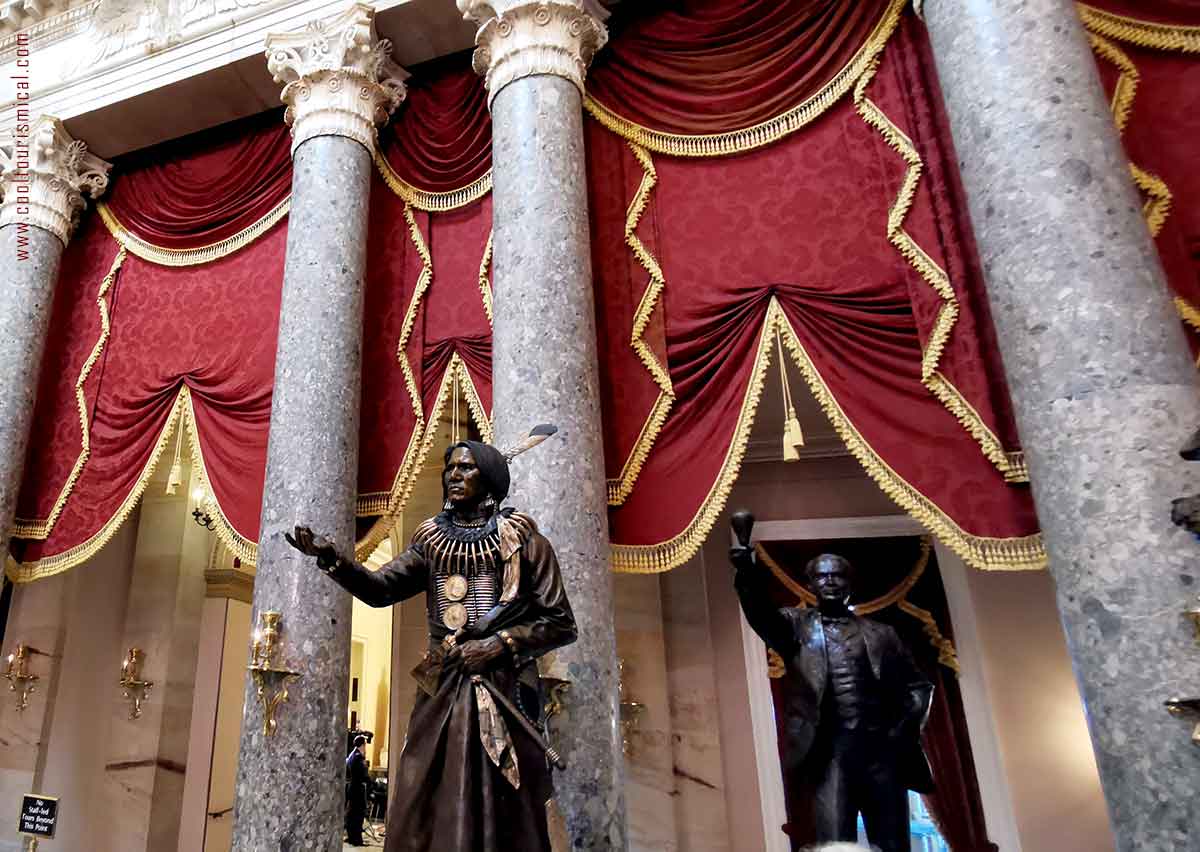
National Statuary Hall, Chief Standing Bear of Nebraska , Copyright © Cooltourismical.com
Last part of the official (and paid) tour leads you inside the National Statuary Hall, which is an early American architectural representation of Greek revival, resembling an ancient amphitheater. Once a meeting chamber for the House of Representatives, the entire space now functions as a gallery with sculptures of prominent Americans from every state, including presidents, inventors, and activists who made some kind of significant national contribution.
You’ll have the opportunity to “meet in person” the First Native American to testify in court, Chief Standing Bear of Nebraska, and the Genius of the Constitution, Liberty, flanked by an eagle and a snake.
These 3 are usually part of the 45-minute free tour. Usually, the free tour concludes back at the Visitor Center, where exhibitions and displays offer further insight into the workings of Congress and the history of the Capitol building. From here you can continnue to the House of Senate.
In case you picked the paid tour, this one continues to the Library of Congress, and you can keep the Senate for the afternoon, after you had lunch.
Visiting Senate & House Galleries (visit on your own)
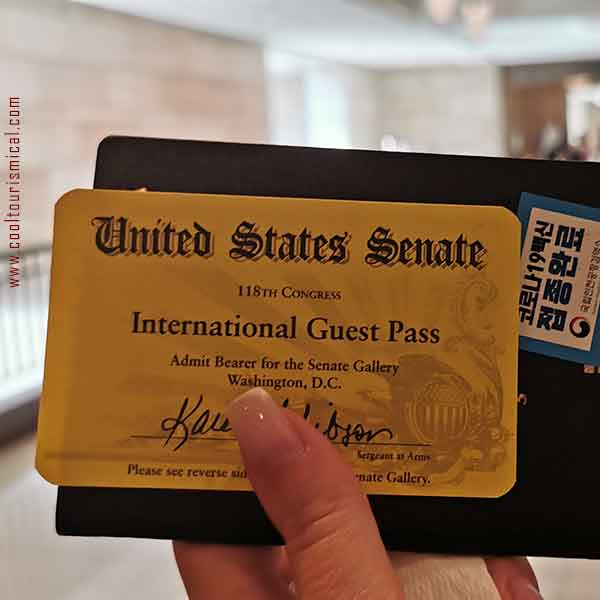
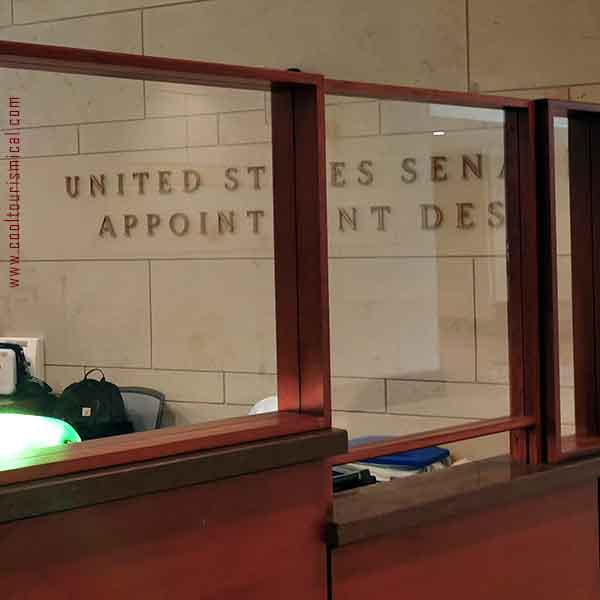
Visiting the Senate at the Capitol, Copyright © Cooltourismical.com
Once you’ve completed the official tour, which takes you through centuries of history and art at the Capitol, you can easily become part of its political life too, even as a foreigner.
A simple visit to the Capitol gives you the opportunity to witness American democracy in action from the Galleries overlooking the committee rooms of Senate and the House, where the day-to-day work of Congress happens.
After the (free) tour, the group returns to the Hall of Emancipation. From here, you can continue on your own to the Congress chambers. If you’ve booked the paid tour, it will move forward to the Library of Congress, and you can visit the Chambers later in the afternoon.
To observe the Senate or House of Representatives in session, you’ll need a gallery pass. As a foreigner, you can get it at the designated desks on the Upper Floor (refer to the map above). Be sure to bring your passport (or another identification document). For citizens, passes are also required and may be obtained from the offices of your senators or representative.
There are specific administration rooms near the check-in desks where you must leave all your belongings. Only your passport is allowed—no phones, cameras, coats, bags, food, or drinks. From there, you’ll be guided to the elevator queues. You’ll go through security screening again to enter the galleries.
The galleries are open whether or not the chamber is in session, typically Monday through Friday. I visited on a Thursday and was informed that the next session would be on Monday. Since it can be challenging to book a ticket for the Capitol tour, there’s no guarantee you’ll be able to tour the Capitol and see the representatives at work on the same day.
While in the galleries, during sessions, you must remain silent. If there is no session, a representative is usually present in the gallery to provide information and answer questions.
Brumidi Corridors (optional specialty tour)
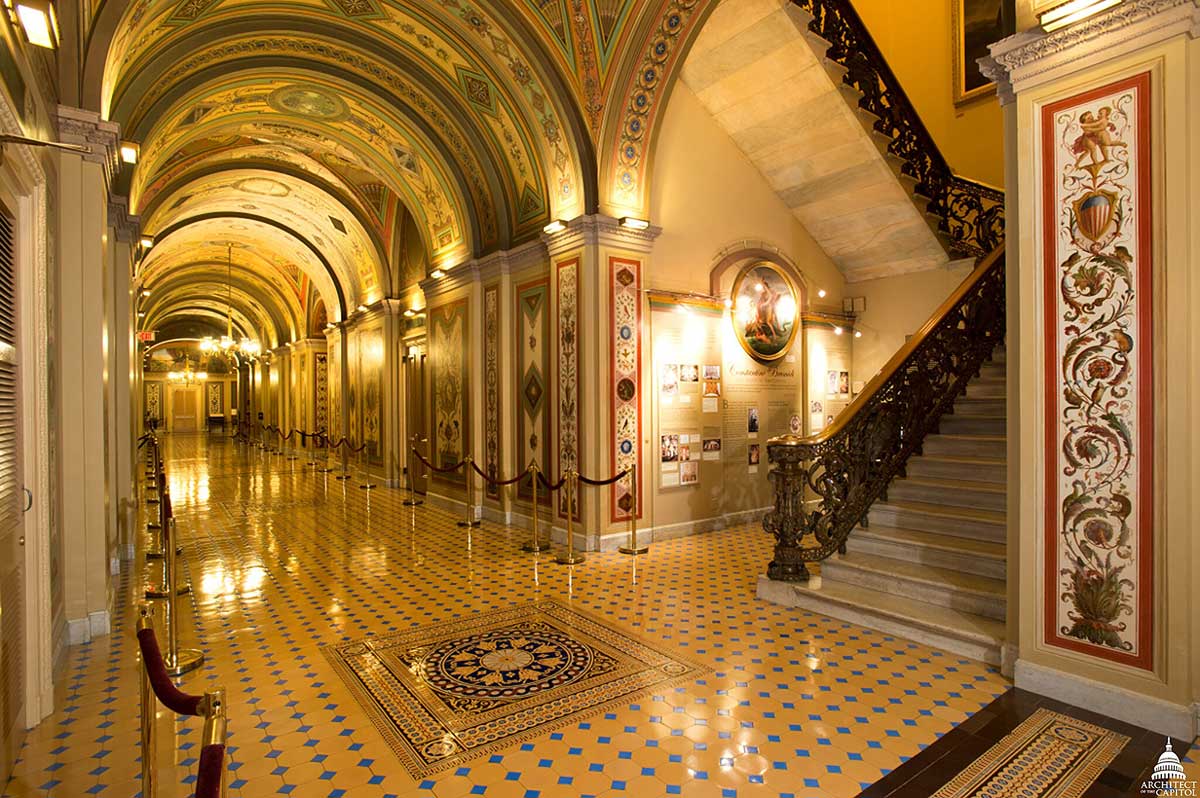
USCapitol, Public domain, via Wikimedia Commons
“Apotheosis of George Washington” fresco found above the Rotunda on the interior of the Capitol Dome is probably the best known masterpiece of the Italian-American artist Constantino Brumidi.
But his work inside the Capitol does not stop there.
He also painted the corridors in the Senate Wing, corridors that today bear his name. He tied his knowledge of classical styles learned in Rome with the American history and nature and managed to create murals that depict scenes from American history, portraits of historical figures, and symbolic representations of virtues, along with images of flora, fauna, and the country’s expansive landscapes. All, a treasure that lines the walls of the Capitol.
This tour is a special one and separate from the regular one (passing the Crypt, Rotunda, National Statuary Hall) and it does not visit the Senate Chamber either. Availability of free passes for this tour can be checked at the information desk in Emancipation Hall.
Monday-Friday at 11 a.m. and 2 p.m. Tour duration: 45 minutes
The Grounds (paid tour or visit on your own)
Designed by the famous visionary landscape architect Frederick Law Olmsted in the 1870s, the same behind the Central Park in New York, the Capitol’s Grounds are a part of the whole “visiting the Capitol” experience: curved walkways, benches, colorful flowers, and more than 4,000 trees, in the same place where once ruled the wilderness of a forest. In fact, the Capitol itself stands upon a land once inhabited by the Monacans, an indigenous American tribe.
It’s a beautiful place, full of history, ideal for a morning or afternoon walk to admire the Capitol from the outside.
Plus, if you search well, you’ll find really interesting sights on the grounds like the Summerhouse, a beautiful open-air building made of red bricks with this unique “basket-weave” pattern on the exterior, a large reflecting pool often visited by ducks and seagulls, and the impressive stone Olmsted Terrace.
If you choose a paid tour, the guide will take you on a short exploration around the Capitol Grounds, most probably before the Capitol official tour. But in case you chose just the free official tour, that’s only for inside the building. So, you can just go and explore the outside park on your own.
 Other Things to Check Inside the Capitol
Other Things to Check Inside the Capitol
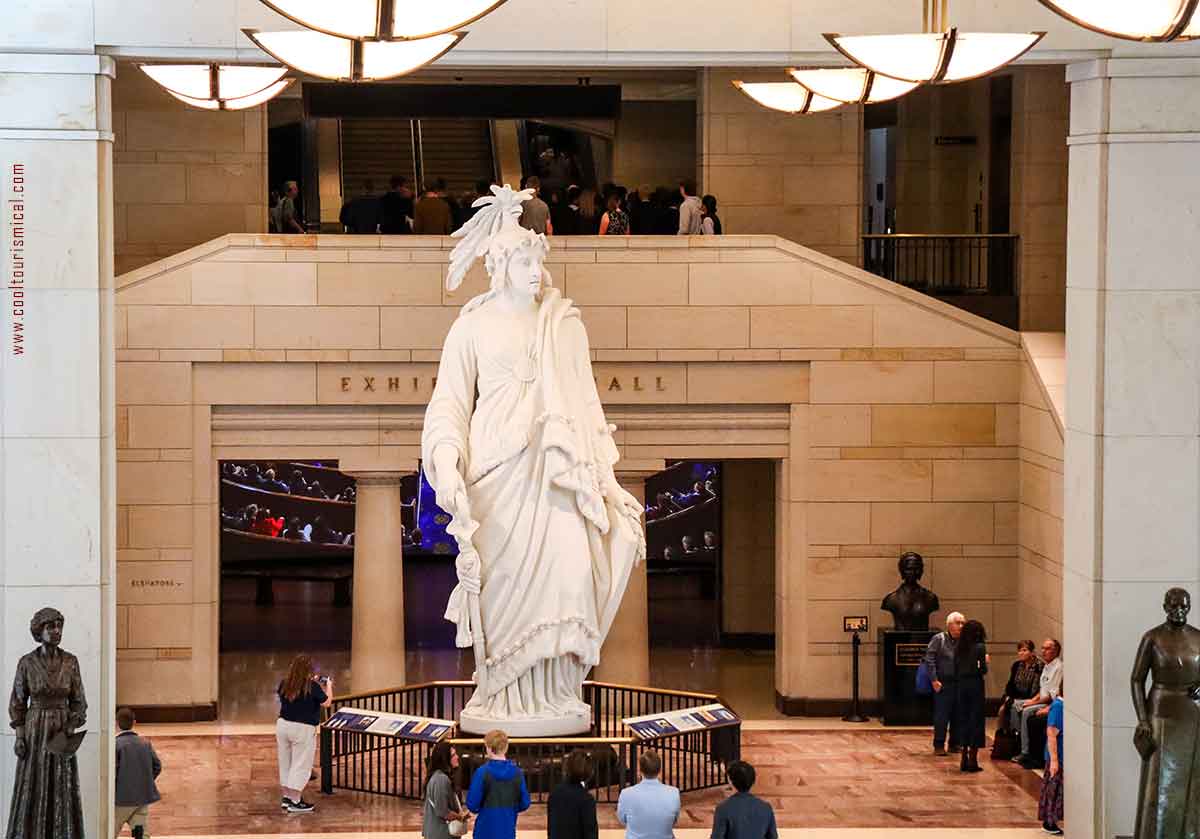
Emancipation Hall, U.S. Capitol in Washington D.C., Copyright © Cooltourismical.com
The Capitol visiting experience begins at the Visitor Center in the Emancipation Hall. This main, grand room, also the departure point for all tours, was named in honor of the enslaved people who contributed to the construction of the Capitol. It features some statues and artefacts that narrate stories of American history and contributions of individuals who have shaped the nation.
Connected to this is the Exhibition Hall, which merges interactive displays with more historical artefacts. If you’re passionate about the subject, it’s the right place to get your dose of information on the legislative process and the history of the building itself. My time there was pretty short. I admit I spent much more time in the Gift Shop. There are so many beautiful souvenirs made in the USA. Loved the seal glass mugs!
If you’re hungry, there is a Café, but there are plenty of restaurants outside the Capitol that are more worth trying out.
 Lunch Break: Capitol Hill Eateries
Lunch Break: Capitol Hill Eateries
If you’re taking a short lunch break, the options for a quick, casual meal like hot dogs, bagels and ice cream, in or around the Capitol, are the Capitol Café inside the Visitor Center and the food trucks parked on the independence Avenue.
But if you have plenty of time, I do recommend moving a bit further away and trying out one of the local delis or restaurants.
Recommended Restaurants Near the Capitol
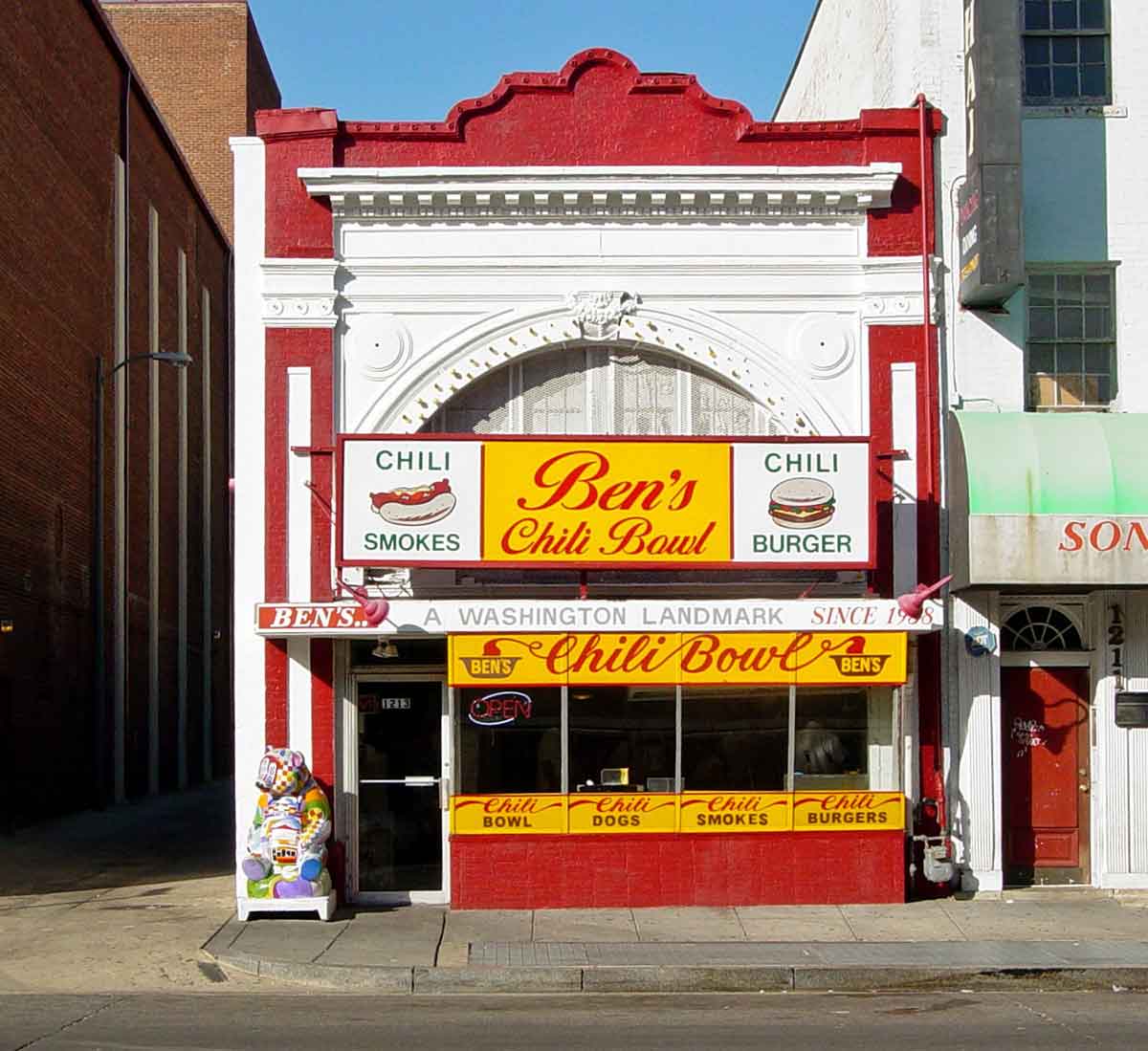
Ben’s Chili Bowl on UStreet, Copyright © Ben Schumin, used under an Attribution-ShareAlike 2.0 License
- The Dubliner: Traditional pub, Irish and American dishes, beer, and live music.
- Ben’s Chili Bowl: Historic spot, spicy hot dogs, chili-cheese fries, and milkshakes.
- The Monocle Restaurant: Over 50 years in business, steaks and wine, closest to the Capitol building.
- Sweetgreen: Fresh, healthy seasonal salads and bowls with locally sourced ingredients.
- Ted’s Bulletin: Classic American diner with all-day breakfast, homemade pop tarts, and milkshakes.
- Ambar: Balkan cuisine with small plates, wines, and cocktails in a stylish setting.
- District Doughnut: Fresh doughnuts in both classic and innovative flavors.
- Pret A Manger: Counter-serve store, organic coffee, sandwiches, salads, and soups.
 Afternoon: Library of Congress & the Botanical Garden
Afternoon: Library of Congress & the Botanical Garden
If you’ve chosen the free guided tour, that stops at the Capitol. And then, you have the whole afternoon to explore Library of Congress on your own. It is the largest library in the world. Its architecture and collections are breathtaking.
Although, it is not in the same building as the Capitol, the Library and the Capitol are connected through underground corridors that to me seemed endless. The access towards the Library is on the upper level of the Visitors Center of the Capitol.
Library of Congress (paid tour or visit on your own)
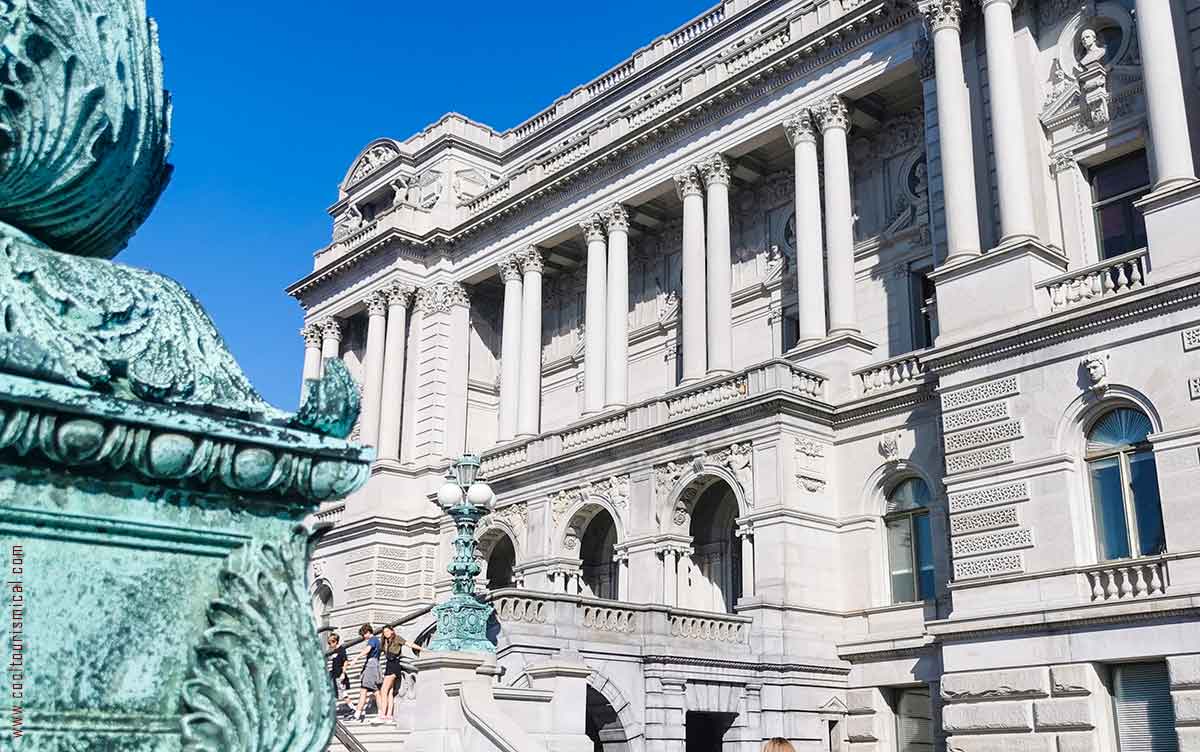
Library of Congress Building, Copyright © Cooltourismical.com
Somewhere on the left side, after you enter the main building, exactly at the access level of the Capitol Visitors Center, there is a sign taking you to the Library of Congress. Although not part of the Capitol building, the Library of Congress is directly across First St. SE from the Capitol and linked through an almost endless underground tunnel.
Library of Congress has some gorgeous interiors, and offers tours, exhibitions, and collections of interest to those who appreciate American history and culture. It’s a must-visit for anyone exploring the Capitol area, with the Thomas Jefferson Building being particularly renowned for its architecture, its Great Hall and the Main Reading Room.
The Great Hall is the entrance hall of the building, a large, colourful chamber with Italian Renaissance-inspired architecture and decorations, opulent marble, grand staircases, and some intricate frescoes. A unique feature of the Library is the “putti” found along the staircases of the Great Hall, each representing different professions or hobbies popular at the time of the Library’s construction.
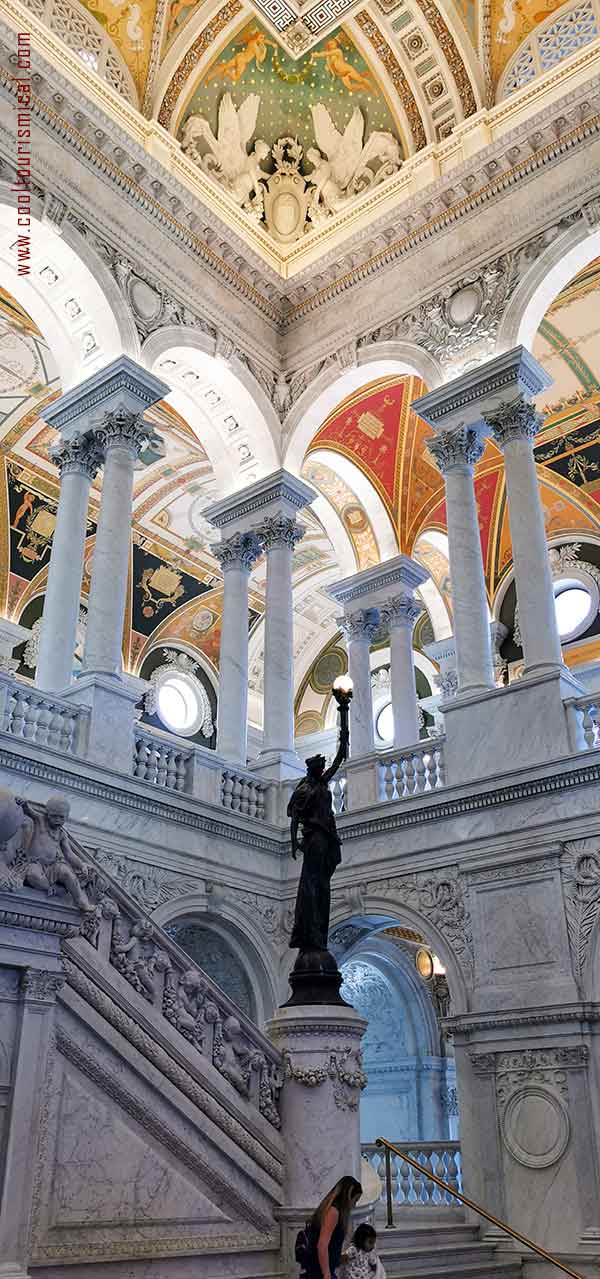
The Great Hall, Copyright © Cooltourismical.com
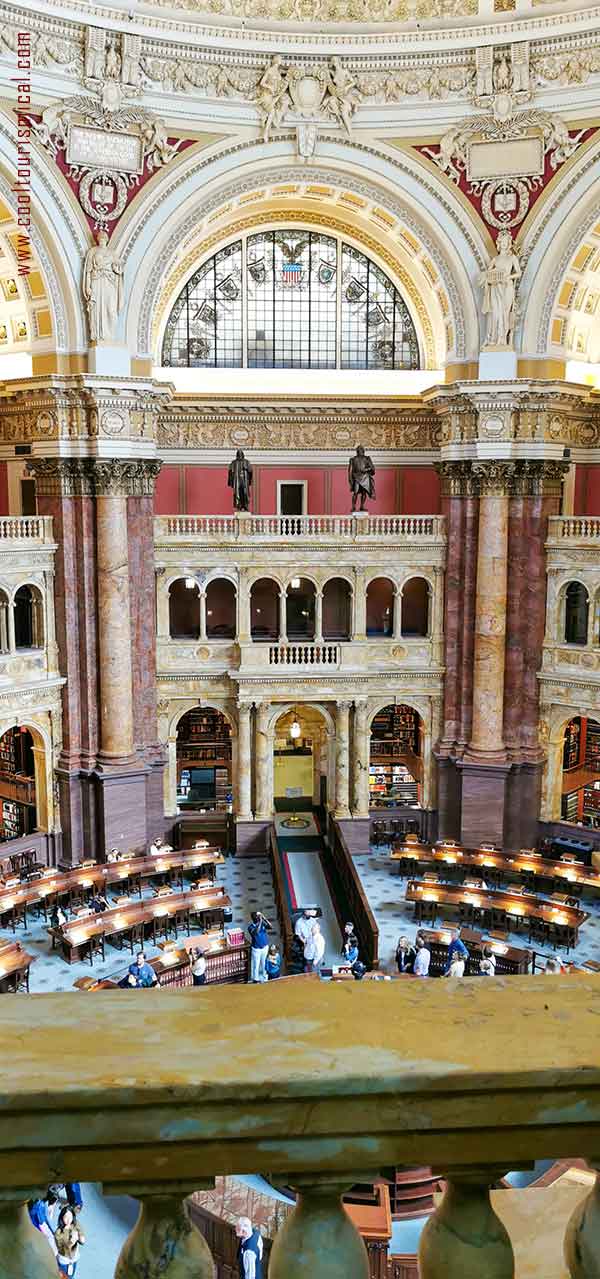
The Main Reading Room, Copyright © Cooltourismical.com
The highlight though is the grand Main Reading Room, typically reserved to researchers, one of the must-see places inside the library. If you’ve chosen only the official free tour and plan to visit the Library in the afternoon, just be careful. The main reading room is not always open and there are also huge cues.
Opening hours for the Reading Room: Tuesday – Friday, 10:30 a.m. – 11:30 a.m. and 2:00 p.m. – 3:00 p.m, Thursdays, 5:00 p.m. – 7:00 p.m. Always check the main website for the updated schedule. I managed to get in at 2. There is a gigantic cue. My advice is to wait in line first fir this and visit the rest of the Library after.
Other things to see include a rare, perfect copy of the Gutenberg Bible, Mosaic of Minerva, “Torch of Learning” and the outside Neptune fountain.
Every visitor, regardless of age, must reserve timed entry passes for the Thomas Jefferson Building. There are instructions everywhere, and you can do that, really fast, from your phone.
The Botanical Garden (visit on your own)
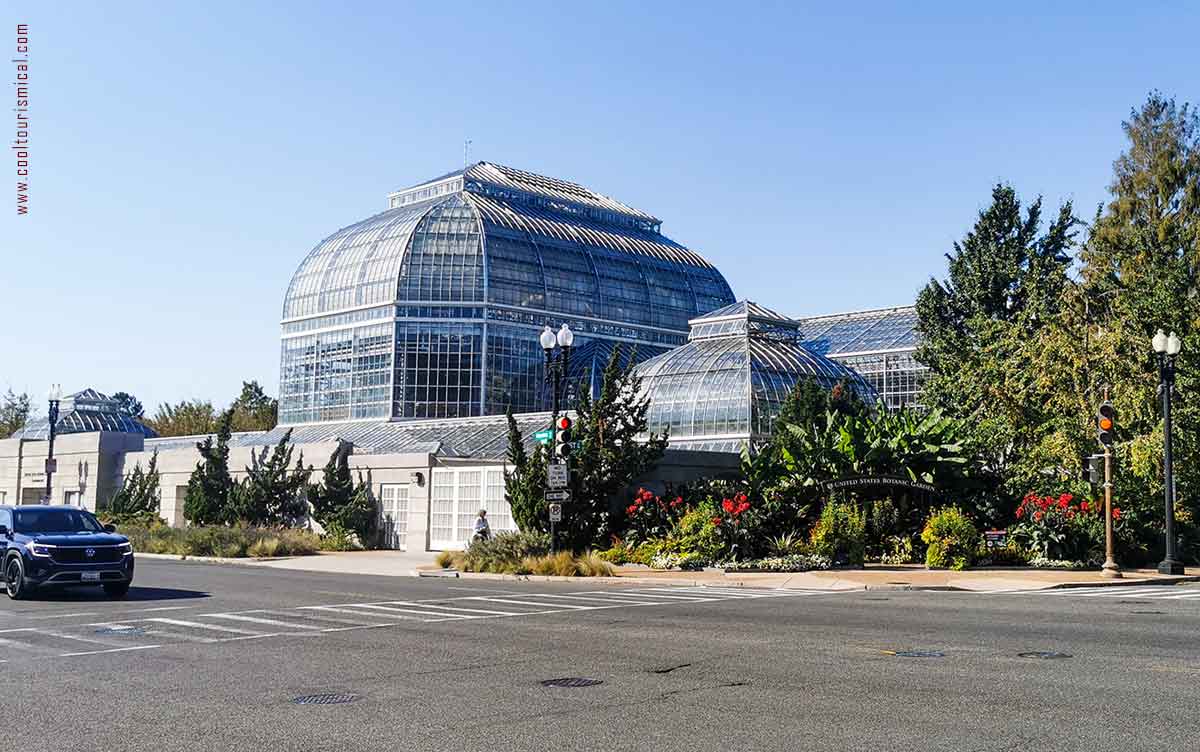
The Botanical Garden in Washington D.C., Copyright © Cooltourismical.com
Once you’ve wrapped up your tour of the marvellous Library of Congress, head down the Independence Avenue towards the Smithsonian Museums on the National Mall. Just before you leave the Capitol grounds, to your right, you’ll easily spot the Botanical Garden, a beautiful exotic oasis lost among all these city giants. The garden is in fact one of the oldest ones in the whole country. Plus, it’s totally free to get in!
First thing first, visit the Conservatory. The massive greenhouse is home to an incredible variety of plants, from tropical to Mediterranean, especially cacti and orchids, where fluttering butterflies stop to rest. And you definitely shouldn’t skip Bartholdi Park right across the street. It’s a must-see!
 Final Thoughts: Is it worth a day at the Capitol?
Final Thoughts: Is it worth a day at the Capitol?
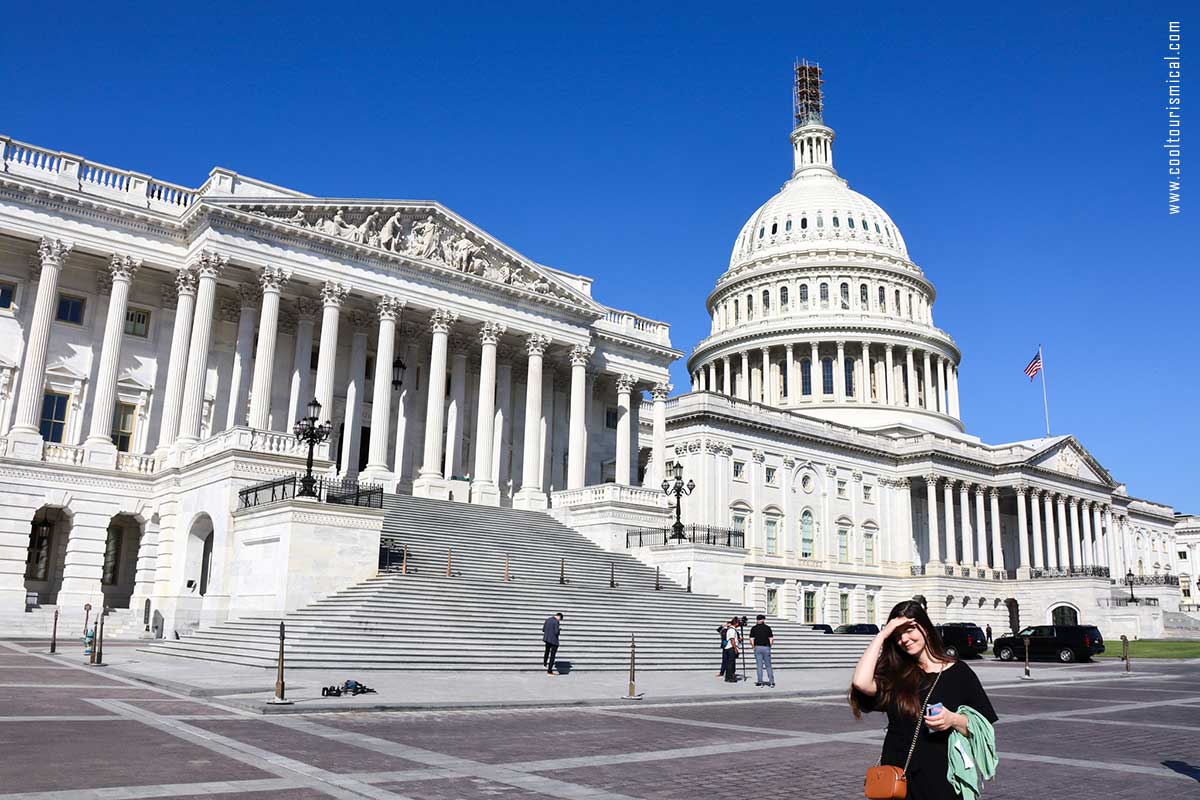
U.S. Capitol Building, Copyright © Cooltourismical.com
Spending a day at the U.S. Capitol means you’ll be right in the heart of American democracy for hours.
Tourist or citizen, you’ll walk the same halls as the nation’s lawmakers. You’ll feel that deep connection to the country’s legislative process and history. It’s a unique chance to really grasp the responsibilities and challenges of governing such a diverse and dynamic nation. Educational and exciting!
Since construction began in 1793, the building has been built, burned, rebuilt, expanded, and restored. Despite these many phases, it has remained the meeting place for the Senate and the House of Representatives for over 200 years.
From the stunning architecture to the rich history in every room and hall, the Capitol is a powerful reminder of the ongoing story of democracy. It’s where history, art, and politics come together—a living, open book about America’s democratic experiment.
The Capitol is definitely a must-see while visiting Washington D.C.! And one day is enough for it.
Additional Tips for Visiting the Capitol:
- 📷 Have your camera with you. You can take wonderful pictures during the official tour of the Capitol and Library of Congress, just not inside the Senate or House.
- 👟 Comfortable shoes are a must. There’s a lot of walking involved.
- 👮 All visitors are required to pass through a security checkpoint. You will not be allowed inside the Capitol with sharp objects, food, liquids and large bags or backpack.
- 🎫 If you haven’t booked in advance, try your luck with a same-day pass from the counters in the Emancipation Hall or choose a paid tour.
 F.A.Q.
F.A.Q.
Can foreigners visit the U.S. Capitol?
Yes, foreigners can visit the U.S. Capitol in Washington, D.C.
As a foreigner you can access same areas national visitors are accessing. This includes taking the official or a paid tour of the historic building, exploring the exhibits, joining the galleries level and watching the Senate and House while in session. Foreign visitors typically need to present a valid passport as identification when entering some areas of the Capitol.
Can you just walk in the U.S. Capitol?
No, you cannot just walk into the U.S. Capitol.
There is a designated entry point for all public tours, through the underground, and you have to follow a set of procedures.
As a visitor, you should have booked a guided tour in advance. Walk-in tours are not usually available, especially during the busy times of the year. Also, you will have to go through a security screening process similar to what you would experience at an airport. This includes metal detectors and bag checks. And always have your passport with you.
While the Capitol is open to the public for tours, not all areas are accessible. For example, the sections where active legislative work is happening,
Can you see the Senate at work? How can I see Congress session?
Watching the Capitol sessions provides a unique insight into the legislative process, and it’s a great experience for those interested in U.S. government. Yes, you can do it! But for both Senate and House of Representatives you will need a gallery pass from the designated desks inside the building.
The galleries are open when either chamber is in session, usually Monday through Friday. The specific hours vary depending on the legislative schedule, which can be checked on the official websites of the Senate and House.
What is the nearest public parking to the Capitol?
Union Station Parking Garage:
- Location: 30 Massachusetts Ave NE, Washington, D.C.
- Distance: About a 10-15 minute walk to the Capitol.
- Details: Union Station has a large parking garage with both short-term and long-term parking options. It’s one of the most convenient and reliable places to park if you’re visiting the Capitol.
Capitol South Metro Garage
- Location: 375 First Street SE, Washington, D.C.
- Distance: About a 10-minute walk to the Capitol.
- Details: Located near the Capitol South Metro station, this garage offers daily parking. It’s a good option if you’re planning to use public transportation or want to park close to the Capitol.
Best hotels near the U.S. Capitol?
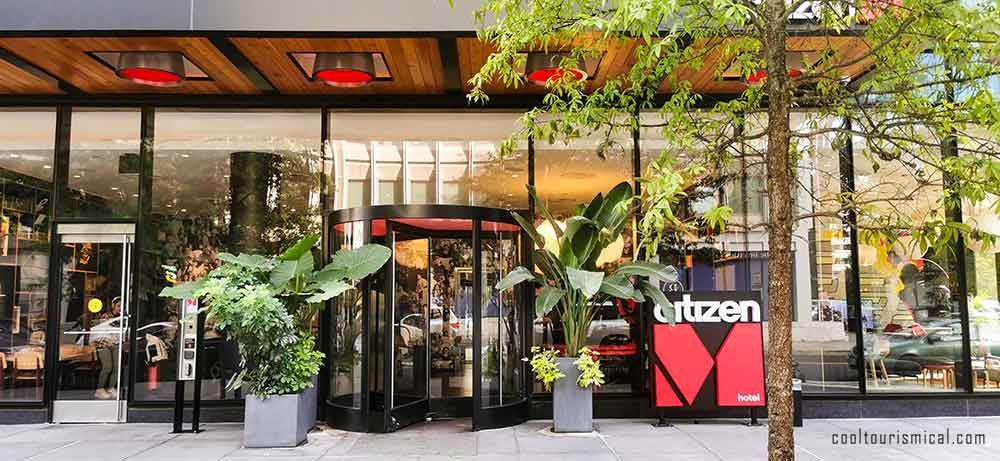
CitizenM Hotel, near the U.S. Capitol, Copyright © Cooltourismical.com
Sure. Here’s a selection of hotels near the U.S. Capitol, grouped by budget, offering options from luxury to budget-friendly, all providing comfort, convenience, and easy access, not only to the Capitol Hill buildings, but also to other Washington, D.C.’s key attractions on the National Mall.
Luxury Hotels
- Kimpton George Hotel (4⭐) – 0.6 miles
Trendy boutique hotel with upscale rooms and a popular on-site restaurant. - Hyatt Regency Washington on Capitol Hill (4⭐) – 0.5 miles
Modern hotel with an indoor pool, fitness center, and on-site dining.
Mid-Range Hotels
- Phoenix Park Hotel (4⭐) – 0.6 miles
Historic charm with European-style accommodations, close to Union Station. - Washington Court Hotel (4⭐) – 0.6 miles
Modern amenities with a stylish bar, perfect for both business and leisure.
Budget-Friendly Hotels
- Capitol Hill Hotel (4⭐) – 0.3 miles
Boutique experience with spacious rooms and complimentary breakfast. - Holiday Inn Washington Capitol – National Mall (3⭐) – 0.7 miles
Family-friendly with a rooftop pool and easy access to the Capitol.
My favorite hotel near the U.S. Capitol:
- CitizenM Washington DC Capitol (4⭐) – 0.7 miles
Chic, modern hotel with compact smart rooms, a rooftop bar, and communal workspaces. You can also read my CitizenM Washington DC Capitol Review.
I hope this guide inspires you to visit the Capitol one day and experience this cornerstone of American history for yourself. If you’ve already visited the Capitol and have additional tips to share, I’d love to hear about your experiences in the comments below.

